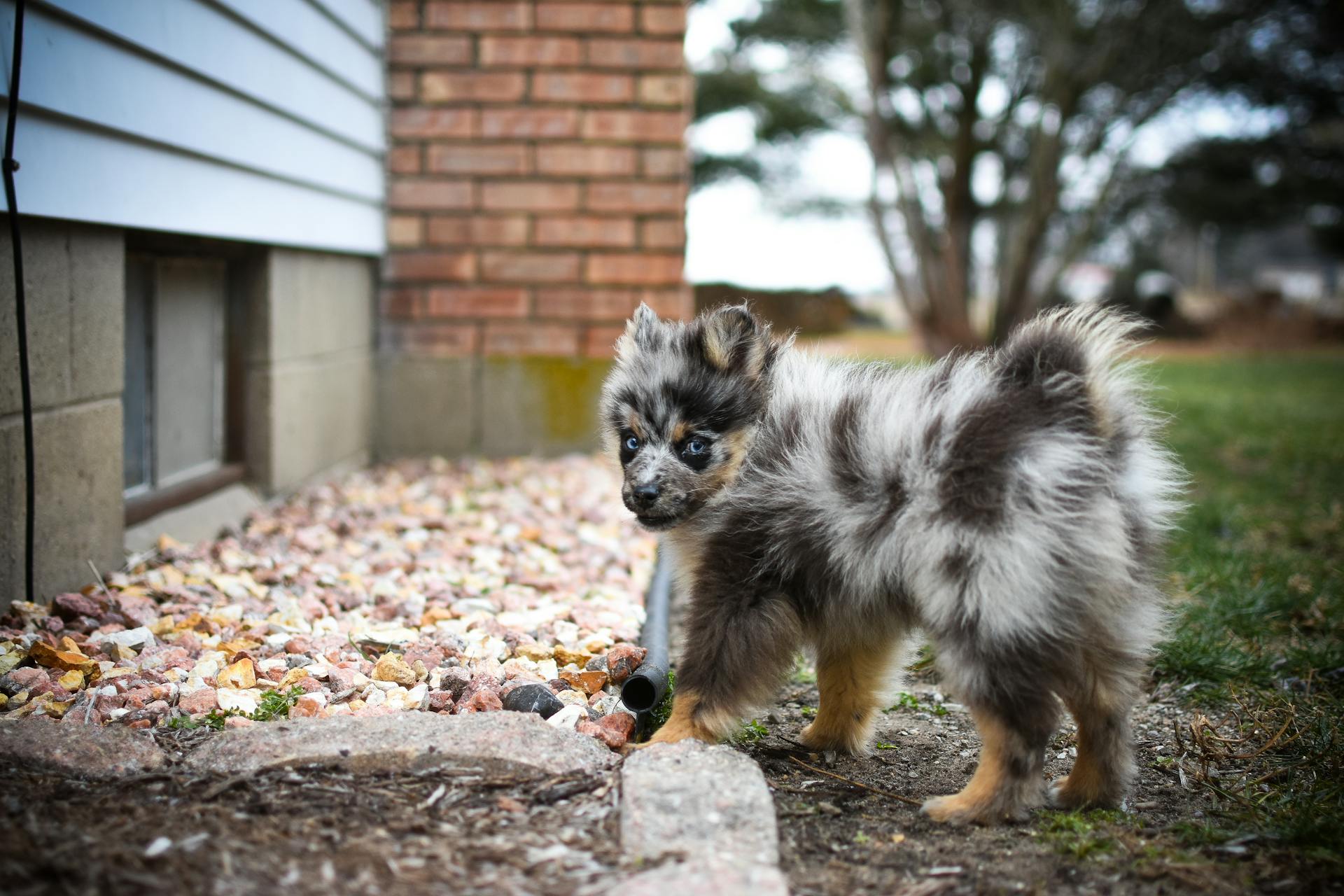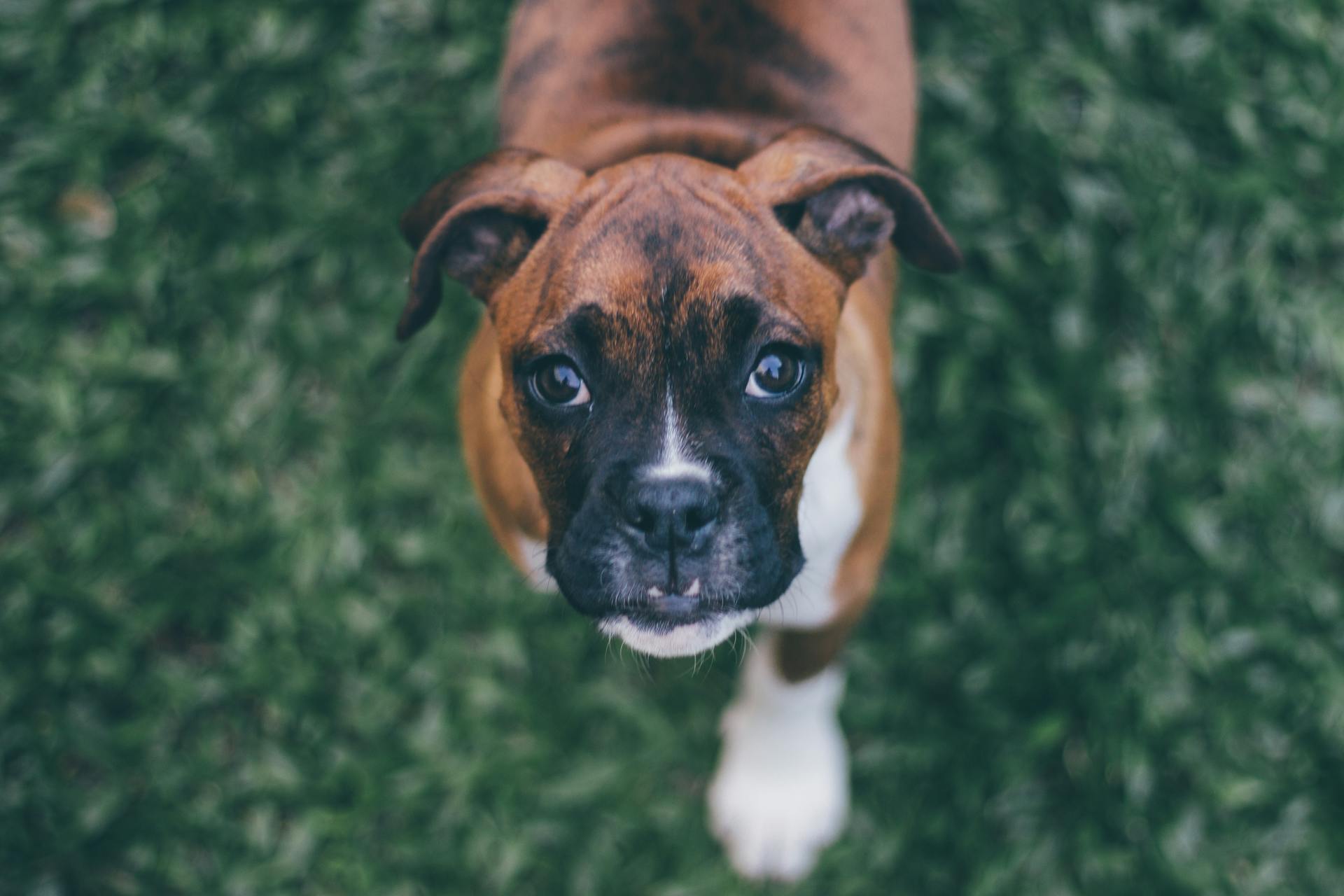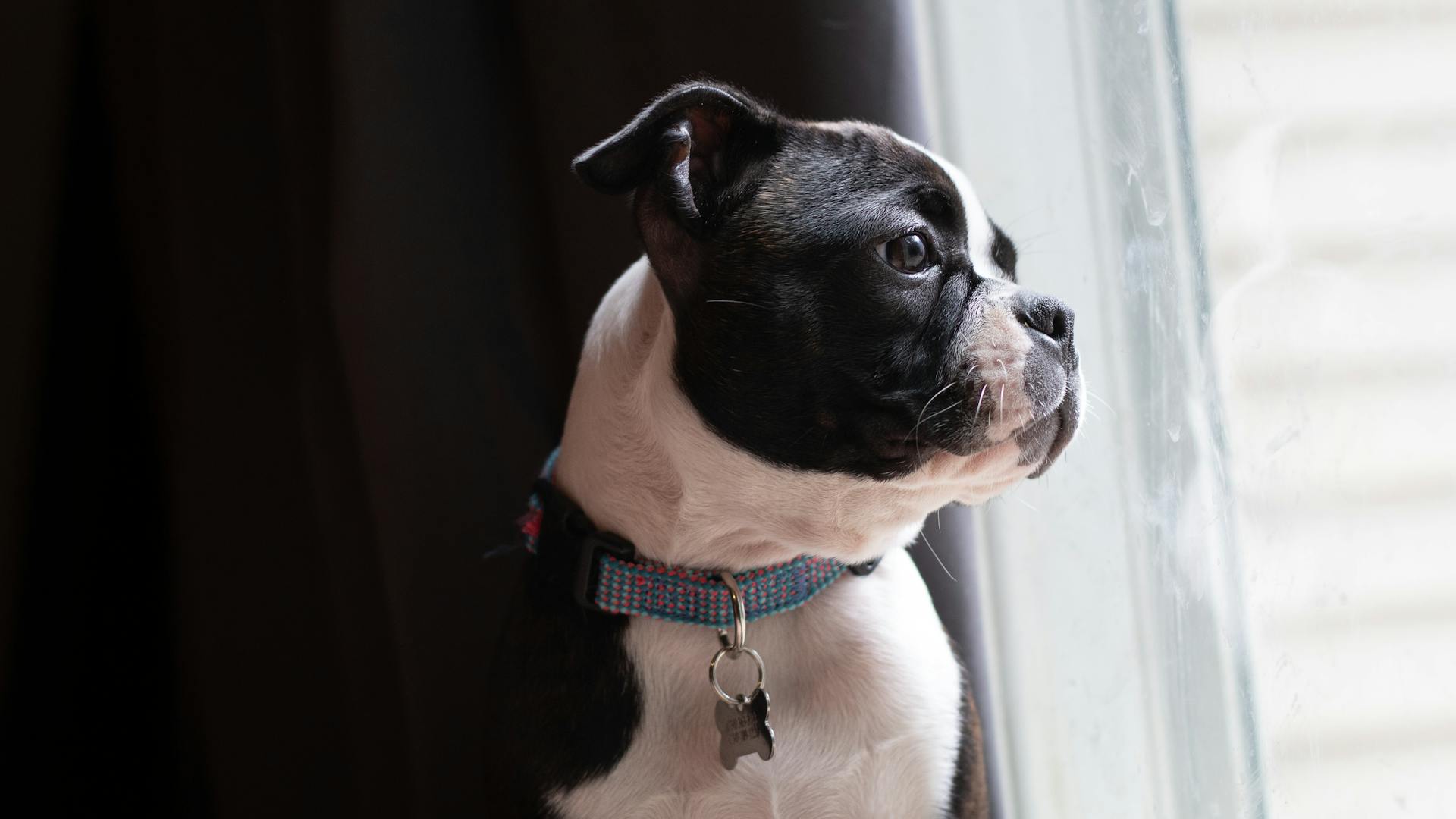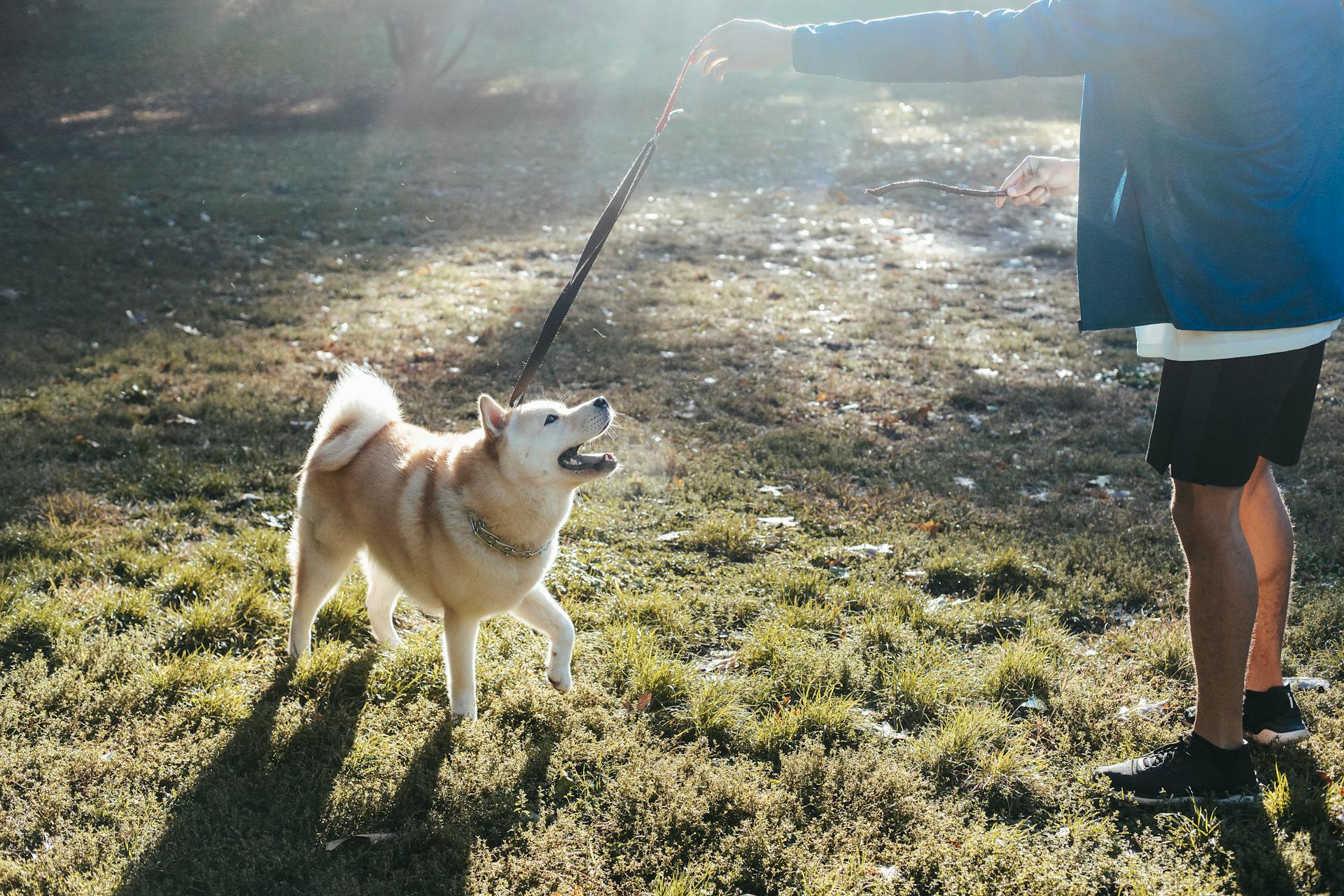
Welcome to the world of puppy training! Housebreaking is one of the most critical aspects of puppy training, and it's essential to establish a routine from the start.
The first step in housebreaking is to create a schedule for feeding and potty breaks. Puppies have small bladders and can't hold their urine for long periods, so frequent breaks are crucial.
Consistency is key when it comes to housebreaking. Take your puppy outside to the same spot each time to create a connection between the location and the action.
Positive reinforcement is a powerful tool in puppy training. Reward your puppy with treats and praise when they eliminate outside, and avoid scolding or punishing accidents.
Discover more: How Long Do Puppies Cry When Crate Training
Basic Obedience Training
Basic obedience training is a crucial part of raising a well-behaved puppy. It includes commands such as "sit", "stay", "recall", "walking on a leash", and proper socialization. Socialization is an essential component of raising and training a puppy to become a well-behaved adult.
To start with basic obedience, you'll want to teach your pup how to properly interact with their surroundings. This means teaching them what their boundaries are and what their role in the world is. You'll also be educating yourself on your pup's personality, strengths, and weaknesses.
Basic obedience is a process, and it's not something that happens overnight. It takes time, patience, and consistency. Start with short training sessions and gradually increase the duration as your pup becomes more focused.
Here are some essential commands to get you started:
- Sit: This is a great first command to teach your pup, and it's easy to understand and execute.
- Stay: This command is essential for keeping your pup safe and preventing them from getting into trouble.
- Recall: This command is crucial for getting your pup to come back to you in situations where they might get distracted.
- Walking on a leash: This command is essential for taking your pup on walks without them pulling on the leash.
Remember, treats are an essential tool in puppy training, so be sure to have a pocket full of high-value treats to reward good behavior. Keep your training sessions short and engaging, and always end on a positive note.
Potty Training
Potty training is one of the most challenging aspects of training a puppy, but with consistency and patience, you can teach your furry friend to go potty in the right spot.
Puppies need to go potty every 1-2 hours, so it's essential to establish a routine that includes frequent trips outside. A good rule of thumb is to take your puppy out after every meal, first thing in the morning, and last thing at night.
To make potty training easier, consider using a crate to confine your puppy to a designated area when you're not supervising. Crates make life easier, and dogs are den animals that will seek out a cozy, enclosed space for security.
A crate should be just large enough for your puppy to stand, turn around, and lie down comfortably, but not so big that they can use one corner as a bathroom and the other as a sleeping area. Place the crate in a common room of your house, not in the basement or garage, to avoid associating the crate with punishment.
Some puppies may be able to hold it longer than others, while some will have to go out every time they play or get excited. You'll need to observe your puppy's individual signals and rhythms to determine their potty schedule.
Here's a rough guide to help you establish a potty training schedule:
Remember, every puppy is different, and you'll need to adjust this schedule based on your puppy's individual needs.
Establishing a consistent potty training schedule is crucial to success. With patience and persistence, most dogs can learn to go potty in the right spot, but it may take some time and effort to get there.
Potty training is not just about teaching your puppy to go potty outside, but also about establishing good habits and preventing accidents in the house. With the right approach and a little bit of creativity, you can teach your puppy to go potty in the right spot and make potty training a breeze.
Socialization and Recall
Socialization is a crucial part of training puppies. It begins with introducing your pup to your family members first, as they will also participate in the process of raising and training the pup.
The process of socialization inside the family circle will help your pup learn how to behave with meeting new people as well. Gradually, you can start introducing your pup to your friends and then to new people.
To socialize your pup effectively, it's essential to expose them to various triggers such as smells, sounds, animals, and people. This will help them remain focused on you and the commands you give.
You should start practicing the recall command at home first and choose an area without distractions. Consistency and regular repetition of the recall word, such as "come" or "here", will help your pup learn to recognize it.
Here's a simple and enjoyable way to teach your puppy a reliable recall:
- Choose a recall word and position yourself on the ground across the room from your helper.
- Call your puppy using the recall word in an upbeat tone, followed by encouraging clapping or kissy noises.
- Reward them with a small treat and lots of praise as soon as they reach you.
- Alternate with your helper in calling your puppy, always rewarding and praising them for coming to you.
Practice and reward are key to mastering the recall command. As your puppy becomes more proficient, gradually increase the difficulty by practicing in different areas of your home and eventually moving to a safe and familiar outdoor environment.
Training Methods and Tips
Training a puppy requires patience, consistency, and positive reinforcement. You should start by ensuring your puppy is well-rested and not overly excited before training, and taking them outside for a potty break before and after each lesson.
To keep your puppy focused, work in a familiar, quiet environment, and use high-value treats to reward good behavior. Choose a crate that's the right size for your puppy, and set it up in a common room of your house.
Here are some key training methods and tips to keep in mind:
- Keep training sessions short and engaging, supplementing with playtime breaks as needed.
- Use puppy treats to make the crate more appealing to your puppy.
- Gradually increase the duration of time your puppy spends in the crate.
- Be mindful of your puppy's age and crate them for a safe "hold time" based on their age in months.
What Should Include
When training your dog, it's essential to understand what should include in your training program. A puppy learns by repeating beneficial behaviors and avoiding those that are disadvantageous.
Start a dog obedience program to establish consistent protocols for you and your dog to follow. This will make training easier for everyone.
Positive reinforcement is a key component of dog training. Reward the behaviors you like with treats, toys, pets, or anything your dog responds to.
Make training fun by keeping sessions short and light. If you're both enjoying yourselves, your training sessions will be more effective.
Here are the essential elements to include in your dog training program:
- Start a dog obedience program
- Use positive reinforcement
- Make training fun
Crate
Crate training is a crucial step in the early stages of training, and it's essential to introduce it gradually and positively. A crate should be introduced gradually and paired with a positive experience in form of treats and toys, so the pup starts associating with something enjoyable.
Choosing the right spot to put the crate is also essential for crate training to be successful. The spot should offer a nice view, but also it should not be placed on a spot, that is too crowded.
To set up your dog crate properly, make sure to choose the right size for your puppy. It should be big enough for them to stand, turn around and lie down comfortably, but not so big that they can use one corner as a bathroom and the other as a sleeping area.
Here are the steps to crate train your puppy:
- Set up your dog crate properly.
- Use puppy treats to start crate training your puppy.
- Feed meals in the dog crate.
- Try interactive dog toys to make the crate more appealing.
- Don't over-crate, as it can lead to accidents and undo the progress made in potty training.
A crate should not be used as a punishment, but rather as a safe space for your puppy to relax and play. Dogs are den animals and will seek out a little canine cave for security, making it relatively easy to train your dog to love their crate.
If you let your dog lose control in their crate, they'll get the idea that it's OK to mess up their living space. Then they'll think nothing of leaving little packages around where you live, too.
Training Methods
Consistency is key when it comes to training a puppy. You should not give up on properly raising and training your pup when challenges occur. Make a schedule, try to stick to it and practice every day (or as often as you can).
Positive reinforcement is a powerful tool in training. Using treats, playing with toys, and pets can help your puppy learn new behaviors. Rewards can be anything your puppy responds to, making it a flexible and effective method.
Short training sessions are essential for keeping your puppy engaged. Pups have a short attention span, and training sessions should remain short, no longer than 10-15 minutes. This will prevent frustration and keep your puppy interested in the training process.
To make the most of your training sessions, keep them short, engaging, and supplemented with playtime. Ensure your puppy is well-rested and take them outside for a potty break before and after each lesson. Treats are an essential tool in puppy training, so make sure to have a pocket full of high-value treats to reward good behavior.
Additional reading: When to Start Crate Training
Here are some essential tips to keep in mind when training your puppy:
- Start with short training sessions (10-15 minutes)
- Use positive reinforcement techniques (treats, toys, pets)
- Keep training sessions engaging and supplemented with playtime
- Ensure your puppy is well-rested and takes potty breaks before and after each lesson
- Have a pocket full of high-value treats to reward good behavior
Remember, every puppy is different, and it's essential to observe and supervise your dog to understand their individual signals and rhythms. Some puppies may be able to hold it longer than others, while some will have to go out every time they play or get excited.
Dog Diet Control
Controlling your dog's diet is crucial for successful housetraining. You should break up your puppy's feeding schedule into three small meals to avoid overwhelming their immature digestive system.
Puppies can't handle a lot of food, so it's essential to choose high-quality puppy food that agrees with them. Examine your puppy's stool regularly to determine if it's time for a diet change. If you notice bulky, loose, and stinky stools, it may be a sign that your puppy needs a new food.
Feeding your puppy too much can lead to diarrhea, making housetraining even more challenging. To avoid this, carefully control their diet and schedule, including the amount of food and the frequency of meals.
Here are some tips to help you control your puppy's diet:
- Break up the puppy feeding schedule into three small meals
- Choose high-quality puppy food that agrees with them
- Examine your puppy's stool regularly
- Avoid overfeeding to prevent diarrhea
Obedience Commands and Tricks
Teaching your puppy obedience commands is a crucial part of their development. Basic obedience includes commands such as "sit", "stay", "recall" (knowing their name and responding to it), "walking on a leash", and proper socialization.
To start, you'll want to teach your pup the most essential commands, such as "sit", "stay", and "recall". You can use a treat to lure them into a sitting position, then gradually phase out the treat and use the cue word "sit" instead.
Once your pup has mastered the basics, you can introduce more complex commands like "place", "leave it", and "heel". For example, to teach the "place" command, stand close to their designated spot and use a treat to get their attention. When they come to their spot, click and reward them.
Socialization is also an essential component of raising and training a puppy. It's not just about teaching them what their boundaries are, but also about educating yourself on their personality, strengths, and weaknesses.
For another approach, see: Training a Dog to Stay
Here are some basic obedience commands and fun tricks that every dog should know:
- Come
- Speak
- Drop it
- Stay
- Back up
These commands give your dog structure and can help you overcome common behavior problems. Once you master the basics, tricks are a great way to take your training to the next level and give your dog mental stimulation.
Some trainers use the luring method, which involves using treats to lure your pup into a certain position. For example, to teach the "sit" command, hold a treat above their head and move it back towards their tail. When they sit, click and reward them.
Others use the capturing method, which involves waiting for your pup to exhibit a behavior naturally, then clicking and rewarding them. This method can be more beneficial in the long term, but it may take longer to achieve results.
Remember, making training fun is key. Keep training sessions short, keep your tone light, and be fair to your pup. If you're both enjoying yourselves, your training sessions will be much more effective.
Troubleshooting and Prevention
Proofing behaviors is crucial to ensure your puppy behaves well in various situations, not just in your living room. Practice, practice, practice - this means practicing behaviors in different locations with varying levels of distraction.
Recognizing common dog behavior problems early on can help you address them before they get out of control. These problems may include unwanted behaviors like chewing, whining, barking, separation anxiety, and reactivity.
To prevent unwanted behaviors, reinforce the wanted ones by providing toys, taking your puppy for walks, exercising it, and leaving it rest in its designated area. Marking good behaviors and rewarding your puppy will prevent misbehavior in the future.
Watch for Unwanted Behaviors
As you're training your dog, it's essential to watch for unwanted behaviors like chewing, whining, barking, separation anxiety, and reactivity. These behaviors can be challenging to address if you don't catch them early.
Paying attention to these behaviors is crucial, but it's equally important not to reinforce them by giving your dog attention when they misbehave. Instead, focus on rewarding good behavior and redirecting your dog's attention.
Providing your dog with toys, taking it for walks, exercising it, and leaving it to rest in its designated area can help prevent unwanted behaviors. You should also mark the good behaviors and reward your dog when it exhibits them.
Common unwanted behaviors include chewing, whining, barking, separation anxiety, and reactivity. These behaviors can be addressed by providing your dog with mental stimulation, exercise, and a designated resting area.
Here are some tips to help you manage unwanted behaviors:
- Practice, practice, practice - practice behaviors in a variety of places with different levels of distraction.
- Recognize common dog behavior problems, such as chewing, whining, barking, separation anxiety, and reactivity.
Vet Clinics
Regular vet check-ups are crucial for your puppy's health and well-being.
Click here to learn more about our vet care, see our upcoming clinic dates and locations, and to make a reservation.
Our vet clinics are designed to be welcoming and stress-free for both you and your puppy.
You can make a reservation online or by calling us directly, it's that easy!
Timeframe: 8-10 Weeks
At 8-10 weeks old, your puppy is ready to start learning the ropes. Establish a daily schedule that includes meals, potty trips, playtime, training lessons, nap time in the crate, and a wind-down routine before bedtime.
To prioritize crate and potty training, make the crate a positive place by rewarding your puppy with treats immediately after they potty outside. This will help them associate the crate with good things.
Your puppy needs socialization, so enroll them in an accredited class and work on social skills in a controlled environment. This will help them become confident and calm in new situations.
To help your puppy become comfortable with alone time, gradually increase the duration of brief departures, starting with just 1-2 hours. This will help them learn to relax and be okay with you leaving the house.
To introduce your puppy to the leash, let them drag it around the house before going for walks and teaching them to walk on it without pulling. This will help them get used to wearing a leash and walking by your side.
Here are some key things to focus on during this timeframe:
- Establish a daily schedule
- Prioritize crate and potty training
- Start socializing your puppy
- Help your puppy become comfortable with alone time
- Introduce your puppy to the leash
- Teach the basic "sit" cue
By following these tips, you'll be well on your way to raising a well-adjusted and well-behaved puppy. Remember to be patient and consistent, and to reward good behavior with treats and praise.
Frequently Asked Questions
What is the first thing you should train your puppy?
Train your puppy with the sit command first, as it's one of the easiest commands to teach and a vital skill for their entire life. Mastering the sit command sets the stage for successful puppy training.
What are the 5 commands for puppy training?
The 5 essential commands for puppy training are "come", "down", "sit", "stay", and "leave it", which help establish basic obedience and self-control. Mastering these commands is a crucial step in shaping your puppy's behavior and strengthening your bond with them.
Where should a puppy sleep at night?
Start with your puppy sleeping in your bedroom, either in a dog bed or crate, for reassurance and a smooth transition. Gradually move them to their permanent sleeping spot as they adjust to their new home
Sources
- https://www.servicedogtrainingschool.org/blog/puppy-basic-obedience-101
- https://www.superiorcare.pet/blogs/news/puppy-training-101-your-guide-to-mastering-basic-puppy-training
- https://www.thesprucepets.com/steps-to-train-your-dog-1118273
- https://www.akc.org/expert-advice/training/how-to-potty-train-a-puppy/
- https://bestfriendspetcare.com/puppy-101-quick-start-guide-caring-new-puppy/
Featured Images: pexels.com


